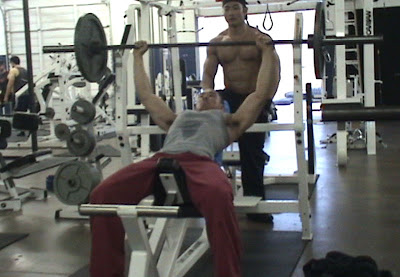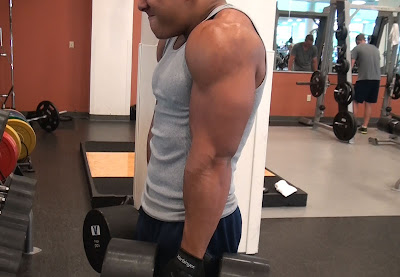This guide will demonstrate some basic exercises for chest. First, lets take a look at this diagram so you know what you're working with.
The chest is basically the pectoralis major which is on top of the pectoralis minor. The pectoralis muscle is a large flat, fan shaped muscle that covers the entire upper rib cage. It originates from attachments along our breast bone, collarbones, ribs, and it inserts on each side of your body via a large tendon through your shoulder joint to your upper arm bone.
Now lets walk you through some basic exercises for training chest.
Bench Press
This is a great upper body exercise. It works the entire pectoral area, delts, and triceps. Secondary stress is applied to the lats , biceps, and forearms to help stabilize and balance the weight.
 |
| Place a barbell on the rack of a bench pressing bench. Lie back on the bench. Place your feet flat on the floor on each side of the bench. Grab the bar just a bit wider then shoulder width. Straighten your arms to lift the barbell off the rack. Position the bar so it is at arms length over your chest. |
**Note**For barbell you may want to have a spotter if you are trying weights you've never done before.
Incline Bench Press
This is very similar to the bench press, it works the same muscle groups but incline bench press works more of the upper chest.
Dips
This exercise works the entire chest area, but it emphasizes the lower chest. It also works the deltoids and triceps.
Dumbbell Flyes
This exercise works the entire chest area, but you can target specific areas of your chest depending on the angle of the bench. For example, a flat bench will target the entire chest, an incline bench will target the upper chest, and a decline bench will target the lower chest.
Machine Flys
This exercise isolates the entire pectoral complex.
Push Ups
This exercise works the entire chest area, but it emphasizes the lower chest. It also works the deltoids and triceps.
 |
| Grab a pair of parallel bars so the palms of your hands are facing each other. Straighten your arms and bend your knees. Support yourself between the bars. |
This exercise works the entire chest area, but you can target specific areas of your chest depending on the angle of the bench. For example, a flat bench will target the entire chest, an incline bench will target the upper chest, and a decline bench will target the lower chest.
 |
| Grab 2 dumbbells and lie back on a bench. Extend your arms straight above chest with the palms of your hands facing each other. Keep a slight bend in your elbows. |
Machine Flys
This exercise isolates the entire pectoral complex.
Push Ups
This is a basic exercise that works the entire chest area. Secondary stress is placed on the shoulders and triceps.
 |
| Lie face down on the floor. Place your hands palms down on each side of your body. Keeping your legs and torso in a straight line push yourself up and support your upper body on your arms. |
 |
| Slowly lower yourself until your chest is about an inch from the floor. Hold this stretched position for a second. Push yourself back up to the starting position. Repeat. **TIP** Push ups are great for warm ups. It gets your upper body's blood flowing with the right amount of weight (your own body weight). |











































